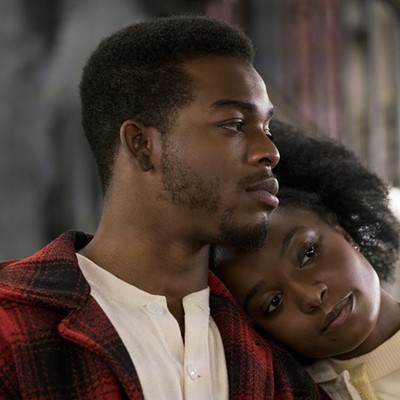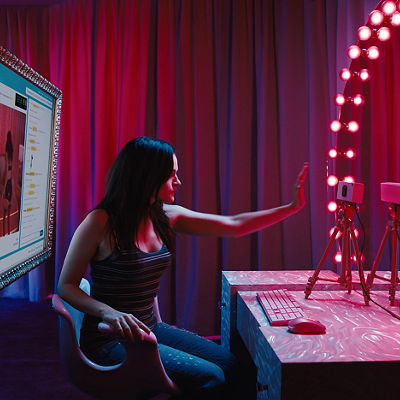How do you document in a film the crack-up of something as complex as a city a quarter-century past? A pair of new documentaries about the Los Angeles riots of April, 1992 take wildly different approaches — and produce wildly different results. In the vigorous and illuminating Let It Fall: Los Angeles 1982-992, writer/director John Ridley (the creator of ABC’s American Crime and Showtime’s Guerrilla) weaves familiar news clips and on-the-street videos with many thorough interviews with men and women whose lives were invariably broken in two by what Ridley’s film calls “the uprising.” No matter their specific circumstances, these residents and police officers found their lives before the city burnt fully sundered from the lives they lived afterwards: Now they had lost loved ones, lost themselves to violence, performed acts of heroism or made choices in the heat of the moment that we still debate today.
Ridley weaves these people’s thoughts and voices throughout his film, identifying them only by name and a title like “South Central resident.” Most viewers won’t know, at first, what role the speakers will play in the riots to come; Ridley invites us to listen without prejudice, to be surprised, deep into the film, when one of his subjects, a black man, exhibits no remorse for beating a white motorist, or when another reports that it was the voice of God that urged him out into the conflagration at Florence and Normandie to save the life of Reginald Denny.
In those days after the misbegotten verdict in the trial of the four police officers who kicked and beat Rodney King, these Angelenos discovered what they and their neighbors were capable of. Ridley’s patient, humane approach allows us, over his film’s 145 minutes, to discover it, too.
He takes pains (and time) to track the climate that made the storm inevitable: Let It Fall opens with a précis on how outrage over many (mostly black) deaths led the (mostly white) LAPD to abandon its chokehold techniques for the whaling of nightsticks — the term alone, so casually phallic, suggests the ugly issues of race, power and masculine rage involved in that weapon’s usage. Then come sober treatments of infamous shootings, some gang-related, and the cops’ and the justice system’s disproportionate responses. After college student Karen Toshima died in the crossfire of a gang shooting in Westwood, police chief Daryl Gates’ Operation Hammer gang “sweeps” arrested hundreds of black residents a night in South Central on pretexts; when store-owner Soon Ja Du shot 15-year-old Latasha Harlins in the back of the head over a misunderstanding about orange juice, the killer was convicted on a charge of voluntary manslaughter but not even sentenced to jail time.
Let It Fall contextualizes this familiar history with the testimony of people who lived it. Here are friends and relatives of Harlins and Du’s, their wounds still raw, speaking plainly about how everything got bad enough for that to happen — and how what came next seemed inevitable.
Inevitability, too, seems to be the lesson of Dan Lindsay and TJ Martin’s more explosive LA 92, a wearying and dispiriting film. (The directors made the excellent high-school football doc Undefeated; LA 92 plays in theaters starting April 28 and on the National Geographic Channel April 30.) They open with the city already in flames, with the Watts riots of 1965. “It was the most widespread, the most destructive racial violence in American history,” a newsman at the time tells us; since the film is assembled entirely from archival footage, it’s left to you, the viewer, to query that sensational claim — what about slavery, you yutz? The directors hinge their narrative on a Frederick Douglass quote: “We have to do with the past only as we can make it useful to the future.”
But their approach fails Douglass. Their movie mostly offers raw footage and shrill media accounts of people shoving, shouting, looting, bleeding, with little sense of what built to this. Both films show us that heart-rending footage of black teenagers stomping on the white drivers of trucks stalled at the Florence and Normandie intersection, but only Let It Fall bothers to cover the drivers being rescued by other young black men.
Both films devote a good stretch of screentime to a Simi Valley jury’s absurd decision in the trial of the officers who beat King, but only Let It Fall digs deeply into how and why the case was moved from Los Angeles to a county where only 2% of the population is black. Let It Fall lets us hear from a juror and from prosecutor Terry White; LA 92, like most of America at that time, relies on TV news. Some of Lindsay and Martin’s footage proves involving and rewarding, of course, especially an extended argument between a white and black man outside the courthouse as the press was waiting for the verdict. But nothing better captures the difference between the films than the responses to the jury’s decision.
In crisp, purposeful montage, Let It Fall shows us Angelenos across the city, gaping and weeping, spitting out anguished prayers and stunned “Oh, God!”s; LA 92 uses similar footage but denies us the people’s actual voices, instead layering on terse, mounting string music. The filmmakers are all too eager to sacrifice real human drama for movie-style suspense. A city’s pain gets silenced in order to create a feeling of rising tension — rather than people, everyone in LA 92 is a drop of water in a pot ready to boil.
LA 92 is about what this all looked like on TV, a sort of Los Angeles Burns Itself — watch a reporter breathlessly describe a man going block by block lighting trees on fire. Let It Fall, meanwhile, prizes what being there actually felt like. Ridley’s film goes much further in incorporating and honoring the perspectives of Korean residents, especially the store owners in South Central and Koreatown whose businesses became targets for looting, though LA 92 offers one long, haunting shot of a woman standing in the window of her shop shouting down the men who approach her with “This is America! This is America!” But only Ridley lays bare how and why such a thing needed to be shouted — and, as Douglass demanded, makes such terror useful to the present and future.
Support Us
Houston's independent source of
local news and culture
account
- Welcome,
Insider - Login
- My Account
- My Newsletters
- Contribute
- Contact Us
- Sign out

Courtesy of Ted Soqui/Getty Images
[
{
"name": "Related Stories / Support Us Combo",
"component": "11591218",
"insertPoint": "4",
"requiredCountToDisplay": "4"
},{
"name": "Air - Billboard - Inline Content",
"component": "11591214",
"insertPoint": "2/3",
"requiredCountToDisplay": "7"
},{
"name": "R1 - Beta - Mobile Only",
"component": "12287027",
"insertPoint": "8",
"requiredCountToDisplay": "8"
},{
"name": "Air - MediumRectangle - Inline Content - Mobile Display Size 2",
"component": "11591215",
"insertPoint": "12",
"requiredCountToDisplay": "12"
},{
"name": "Air - MediumRectangle - Inline Content - Mobile Display Size 2",
"component": "11591215",
"insertPoint": "4th",
"startingPoint": "16",
"requiredCountToDisplay": "12"
}
,{
"name": "RevContent - In Article",
"component": "12527128",
"insertPoint": "3/5",
"requiredCountToDisplay": "5"
}
]
KEEP THE HOUSTON PRESS FREE...
Since we started the Houston Press, it has been defined as the free, independent voice of Houston, and we'd like to keep it that way. With local media under siege, it's more important than ever for us to rally support behind funding our local journalism. You can help by participating in our "I Support" program, allowing us to keep offering readers access to our incisive coverage of local news, food and culture with no paywalls.
Alan Scherstuhl is film editor and writer at Voice Media Group. VMG publications include Denver Westword, Miami New Times, Phoenix New Times, Dallas Observer, Houston Press and New Times Broward-Palm Beach.
Contact:
Alan Scherstuhl
Follow:
Twitter:
@studiesincrap
Trending Film
- International Film Festival 2000
- Jonah Hill’s Mid90s Takes an Honest Plunge Into the Millennial Past
- Speed Racer Is a Fast Track to Nowhere
-
Sponsored Content From: [%sponsoredBy%]
[%title%]

Don't Miss Out
SIGN UP for the latest
news, free stuff and more!
Become a member to support the independent voice of Houston
and help keep the future of the Houston Press FREE
Use of this website constitutes acceptance of our
terms of use,
our cookies policy, and our
privacy policy
The Houston Press may earn a portion of sales from products & services purchased through links on our site from our
affiliate partners.
©2024
Houston Press, LP. All rights reserved.





